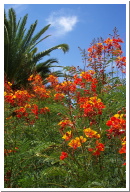We had the arborists in today to make some, somewhat overdue, alterations to several trees in the front yard.
Are huge elm tree was looking quite shaggy, with its drooping branches reaching down into the driveway and up and over the fireplace chimney. Of course, I only got to see the end result, as I was off solving people's computer problems today, and arrived home long after all the work was done. That was a bit odd, for me, as I usually like to be around for this type of work. My computer consulting business has been quite busy the last few months as I have worked diligently to smooth out the typical ups and downs of business. This means I am spending much more time out of the garden instead of in.
Work in the garden never fails to yield more work, though. Although the owner of the tree company was very careful to remove sprinkler heads and landscape lights that might be in danger of damage, one sprinkler head decided to cracks its base fitting somehow. This will mean digging up the section of pipe and praying that the galvanized fittings have not become hopelessly fused into one corroded mass. Previous experience has shown this to often be the case. As soon as the area dries out a bit, I will dig it up and figure out the state of affairs. Then, yet another trip to Home Depot.
The landscape lights fared better, but several of them didn’t work at sundown tonight. This is actually fairly typical with these cheap lights I bought at CostCo. Maybe tomorrow evening I will try and get all them working as well.
The biggest benefit of the tree trimming is much more light in the living room. While it is still high-summer here, the extra light is appreciated, even if the extra heat, is not.
Life rolls on this summer, though and both my son and wife are heading back to school in a few short weeks. Why did summers seem so long when we were young and so short now. Yet one more thing to cause you to regret getting older.






